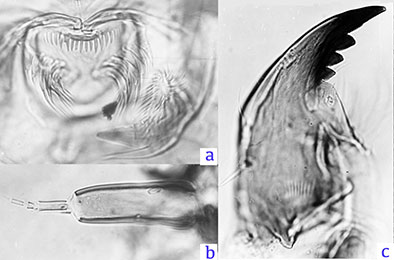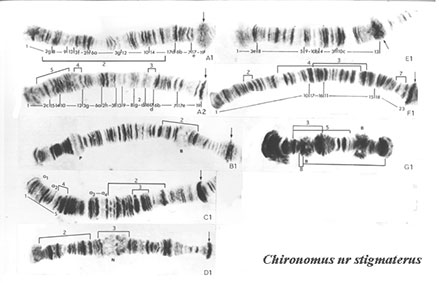Species 5v. Chironomus nr. stigmaterusIn BOLD Bin: BOLD:AAW3998Adult and Pupa: I have no information definitely relating to this form.Fourth instar larva: A plumosus type larva, but larval bodies were discarded and only the head capsules retained. Data only available for two specimens and is largely similar to that of C. stigmaterus, although at the lower end of the range.
The gula is darkened, the frontoclypeus less so but with a darker stripe along the center. The salivary reservoir is 78 x 30 µm (2.58 times wider than deep). Mentum width about 0.54 of the VHL; 4th laterals hardly reduced and center tooth type IB.
The ventromentum is about 220 µm wide; 3.95 times wider than deep and 1.3 times the mentum width; with 45-60 striae; VMR 0.32-0.41. The number of Pecten epipharyngis teeth (18, of type B) is relatively high given the small size of many other measures. The premandible is type B2 with the inner tooth 3-3.8 times the width of the fine pointed outer tooth.
The relative lengths of the antennal segments and the AR (2.16-2.31) are similar, although again at the lower range of those of C. stigmaterus.
The distance between the S4 setae (157 µm) is less than that between the antennal bases (185 µm) and 0.85 of the Frontoclypeus width.
Mandible with 3rd inner tooth well developed and darked (type IIIC); about 16-18 furrows on outer surface near the base; 10-11 taeniae in the PMa; Mdt-Mat 41; MTR 0.42-0.45. 
(a) Pecten epiharyngis, premandible; (b)antenna, and (c) mandible of C. nr. stigmaterus Cytology: 4 polytene chromosomes with the thummi arm combination AB, CD, EF, G.
Centromere are heterochromatic. Arm G closely paired with 2 interstitial BRs in arm G. Nucleolus is about the middle of arm D. Inversions are known in all arms except arm E, although with low polymorphism (Hilburn 1979). nrstiA1: 1a-2g, 8-9, 13a-f, 3f-2h, 6a-3g, 12c-10, 14-17d, 6b-7, 17e-19 (all localities, highest Texas)
nrstiA2: 1a-2c, 15-14, 10-12, 3g-6a, 2h-3f,13f-a, 9-8, 2g-d, 16-17d, 6b-7, 17e-19 (all localities, highest California)
nrstiA5: approx 1a-f, 11e-10, 14-15, 2c-1g, 12a-c, 3g-6a, 2h-3f, 13f-a, 9-8, 2g-d, 16-17d, 6b-7, 17e-19 (California)
nrstiB1: Puff with distal dark bands (groups 7 & 8) near end of arm, BR near characteristic 4 bands (24-26) (in all localities)
nrstiB2: Inversion of region around BR, about groups 21-23 (California)
nrstiC: Four sequences are known, only C1 and C2 common (all localities)
nrstiC3: small proximal inversion within region of C2 (California)
nrstiC4: small distal inversion (California)
nrstiD: Three sequences known, but only D1 common (all localities)
nrstiD3: small inversion of region of nucleolus (California)
nrstiE1: 1-3e, 8-5, 9-10b, 4-3f, 10c-13 i.e. as maturus (differs from aberratus by In8-5) (all localities)
nrstiF1: 1-10, 17-16, 11-15, 18-23 i.e. derived from aberratus by In11-5
nrstiF2: 1-4, 6a-5, 6b-10, 17-16, 11-15, 18-23 heterozygous in all males
nrstiF3: 1-4, ?-?, 6b-10, 17, 14h-11, 16d-a,15a-i, 18-23 (could be 1-10 or 1-4, 6a-5, 6b- 10) (California)
nrstiF7: approx 1-10, 17-16, 11a-15i, 18-20g , 22d-20h, 22e-23 (California)
nrstiG1: Two BRs, one near each end of arm (throughout, but highest in California) 
Polytene chromosomes of C. nr. stigmaterusFrom the distribution of some other species that are shared between California and South America, it is possible that this is the form of C. stigmaterus reported from Mexico and Cuba. However there is no information on which to base such such a conclusion - in fact the existence of a form of C. stigmaterus in Cuba is based entirely on a publication simply reporting the presence of the species (Bello Gonzalez 2010). [ Return to Index| Return to Index | Go to C. stigmaterus | Go to C. stigmaterus cytology ]
Created: 17 September 2022
Access: Unrestricted
Copyright ©2022, Jon Martin. |

